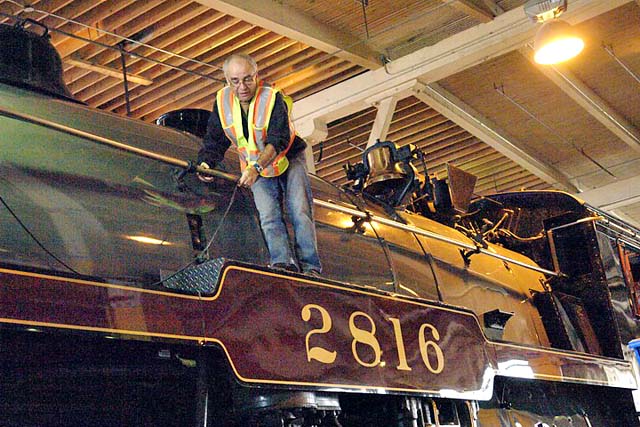
2011
|


A member of the Rocky Mountain Express film crew wires up 2816 for sound recording - Don Gaynor.
30 September 2011
A Train Trip Into History
Hull Quebec - The story of the trans-Canada railroad has been told many times, but there's a special lift in watching it from the front
of old 2816, a 4-6-4 Hudson class H1b locomotive. In the 1930s, 2816 pulled passenger trains between Winnipeg and Calgary. Since 2001, it has been renamed the
Empress and tours Canada as a steam-driven goodwill ambassador for Canadian Pacific Railway.
And in the new film "Rocky Mountain Express", it's both guide into history and sometime tripod for giant Imax cameras, chugging along beside winding
rivers, puffing over winding mountain passes, and roaring along on vertiginous trestles.
"They once roamed the Earth in the tens of thousands," says narrator Michael Hanrahan, making the engine sound like the immense dinosaurs, another
story that's been told many times, of previous IMAX movies. Indeed, with its intricate system of pipes and valves, pouring steam from every orifice as it chugs
noisily across this or that mountain range, 2816 looks like some giant, improbable, prehistoric beast. It's what would happen if Victorian engineers designed a
tyrannosaur.
Much about the railway is giant and improbable, and once director Stephen Low moves the camera from the front of the locomotive, Rocky Mountain Express is a
journey back in time to tell its story. Starting in Vancouver and going east, the film combines the amazing vistas of the Selkirk and Rocky mountain ranges and
the breathtaking beauty of the place they call Banff (a locale that would eventually save the railway, bringing in tourist dollars to offset the high cost of
trans-mountain transport) with a survey of the characters who thought they could somehow run train tracks through a forbidding wilderness.
These include William Cornelius Van Horne, the American-born executive who was responsible for the project, and Albert Bowman Rogers, the American surveyor who
found a route through the Selkirks, Rogers Pass, that turned out to be a lot more trouble than advertised. Using old black-and-white photos (amazingly crisp on
the huge screen), Rocky Mountain Express also salutes the many anonymous workers who chopped, blasted, dug, and died to make the railway run. In the 1880s,
10,000 men worked to build track through the Fraser Canyon, 6,500 of them Chinese. They made five feet a day (later, when things got smoother, the crews laid
500 miles (Editor: Approximate.) of track in a single season, which was a world record) and perished at the rate of six men a mile.
Rocky Mountain Express is filled with such detail: This is a film that puts "educational" squarely in the middle of the IMAX mandate. There are
maps that illustrate how twisty tunnels overcame some engineering problems, and animated little lines that demonstrate which stretch of track we're on as the
CPR moves relentlessly toward Montreal. Landslides bury towns. Avalanches kill workers. One particularly unlucky locomotive keeps tipping off the track or
blowing up, but it's rebuilt each time and runs for another 30 years.
Low (The Ultimate Wave, Tahiti, Super Speedway) has developed an easy facility with the IMAX format, and while Rocky Mountain Express rumbles through huge
swaths of information, it's always visually interesting. The railway has its own romance, and part of it is the perils of how it got there.
ROCKY MOUNTAIN EXPRESS
Narrated by: Michael Hanrahan;
Directed by: Stephen Low;
Playing at: Canadian Museum of Civilization Imax and the Ontario Science Center in Toronto.
Jay Stone.

|

